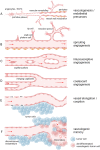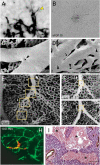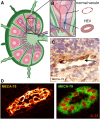Pathological angiogenesis: mechanisms and therapeutic strategies
- PMID: 37060495
- PMCID: PMC10105163
- DOI: 10.1007/s10456-023-09876-7
Pathological angiogenesis: mechanisms and therapeutic strategies
Abstract
In multicellular organisms, angiogenesis, the formation of new blood vessels from pre-existing ones, is an essential process for growth and development. Different mechanisms such as vasculogenesis, sprouting, intussusceptive, and coalescent angiogenesis, as well as vessel co-option, vasculogenic mimicry and lymphangiogenesis, underlie the formation of new vasculature. In many pathological conditions, such as cancer, atherosclerosis, arthritis, psoriasis, endometriosis, obesity and SARS-CoV-2(COVID-19), developmental angiogenic processes are recapitulated, but are often done so without the normal feedback mechanisms that regulate the ordinary spatial and temporal patterns of blood vessel formation. Thus, pathological angiogenesis presents new challenges yet new opportunities for the design of vascular-directed therapies. Here, we provide an overview of recent insights into blood vessel development and highlight novel therapeutic strategies that promote or inhibit the process of angiogenesis to stabilize, reverse, or even halt disease progression. In our review, we will also explore several additional aspects (the angiogenic switch, hypoxia, angiocrine signals, endothelial plasticity, vessel normalization, and endothelial cell anergy) that operate in parallel to canonical angiogenesis mechanisms and speculate how these processes may also be targeted with anti-angiogenic or vascular-directed therapies.
Keywords: Angiogenesis; Anti-angiogenesis; Endothelial cells; Immunotherapy; Vascular biology; Vascular targeting.
© 2023. The Author(s).
Conflict of interest statement
The authors declare no competing interests.
Figures









Similar articles
-
Tumour vascularization: sprouting angiogenesis and beyond.Cancer Metastasis Rev. 2007 Dec;26(3-4):489-502. doi: 10.1007/s10555-007-9094-7. Cancer Metastasis Rev. 2007. PMID: 17717633 Free PMC article. Review.
-
Glycosylation as new pharmacological strategies for diseases associated with excessive angiogenesis.Pharmacol Ther. 2018 Nov;191:92-122. doi: 10.1016/j.pharmthera.2018.06.003. Epub 2018 Jun 29. Pharmacol Ther. 2018. PMID: 29909237 Review.
-
[Rationale of antiangiogenic therapy].Magy Onkol. 2006;50(2):141-51. Epub 2006 Aug 4. Magy Onkol. 2006. PMID: 16888678 Review. Hungarian.
-
Blocking VEGFR-3 suppresses angiogenic sprouting and vascular network formation.Nature. 2008 Jul 31;454(7204):656-60. doi: 10.1038/nature07083. Epub 2008 Jun 25. Nature. 2008. PMID: 18594512
-
Tumor cell-mediated neovascularization and lymphangiogenesis contrive tumor progression and cancer metastasis.Biochim Biophys Acta. 2013 Dec;1836(2):273-86. doi: 10.1016/j.bbcan.2013.08.001. Epub 2013 Aug 8. Biochim Biophys Acta. 2013. PMID: 23933263 Review.
Cited by
-
Canthin-6-One Inhibits Developmental and Tumour-Associated Angiogenesis in Zebrafish.Pharmaceuticals (Basel). 2024 Jan 12;17(1):108. doi: 10.3390/ph17010108. Pharmaceuticals (Basel). 2024. PMID: 38256941 Free PMC article.
-
Low-dose apatinib optimizes the vascular normalization and enhances the antitumor effect of PD-1 inhibitor in gastric cancer.Transl Cancer Res. 2024 Aug 31;13(8):4290-4300. doi: 10.21037/tcr-23-2328. Epub 2024 Aug 19. Transl Cancer Res. 2024. PMID: 39262493 Free PMC article.
-
The effects of suppressing inflammation by tofacitinib may simultaneously improve glycaemic parameters and inflammatory markers in rheumatoid arthritis patients with comorbid type 2 diabetes: a proof-of-concept, open, prospective, clinical study.Arthritis Res Ther. 2024 Jan 4;26(1):14. doi: 10.1186/s13075-023-03249-7. Arthritis Res Ther. 2024. PMID: 38178250 Free PMC article.
-
S100A16 stabilizes the ITGA3‑mediated ECM‑receptor interaction pathway to drive the malignant properties of lung adenocarcinoma cells via binding MOV10.Mol Med Rep. 2025 Jan;31(1):11. doi: 10.3892/mmr.2024.13376. Epub 2024 Oct 25. Mol Med Rep. 2025. PMID: 39450567 Free PMC article.
-
Glycometabolic Regulation of Angiogenesis: Mechanisms and Therapeutic Strategies.Int J Mol Sci. 2025 Mar 7;26(6):2386. doi: 10.3390/ijms26062386. Int J Mol Sci. 2025. PMID: 40141029 Free PMC article. Review.
References
-
- Griffioen AW, Molema G. Angiogenesis: potentials for pharmacologic intervention in the treatment of cancer, cardiovascular diseases, and chronic inflammation. Pharmacol Rev. 2000;52(2):237–268. - PubMed
Publication types
MeSH terms
Substances
Grants and funding
LinkOut - more resources
Full Text Sources
Medical
Miscellaneous

